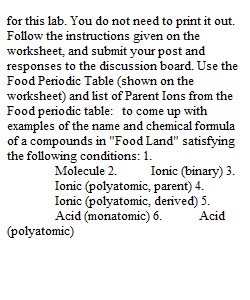


Q Overview The purpose of this activity is to help you practice applying the nomenclature rules you learned from your textbook readings and from watching my videos. To do: Download the worksheet: Nomenclature in Food Land Purpose In this exercise, you will be applying all of the nomenclature rules you learned to come up with names and chemical formulas of compounds in Food Land. Introduction In Food land, there are two different types of elements - meats and non-meats shown in the periodic table below. In addition to the meats and non-meats, oxygen and hydrogen also exist. Both hydrogen and oxygen have the same properties in Food Land as on Earth. Meats and non-meats can be combined in different ways, following the same rules you learned in your textbook. Non-meats can make monatomic anions, parent oxyanions and derived oxyanions, depending on group. The meats can all take on more than one oxydation state (+1, +2, +3, +4). The most common oxydation state for the meats are shown in the column heading. Treat all meats as Type II ions. Examples of compounds and various types of possible ions are shown below. Molecules Name Chemical Formula dicabbogen trirasberride C2R3 zuccinogen choysumide ZCs broccogen tripumpkinide BP3 Monatomic Ions Name Chemical Formula cabbide ion C2– cucumbide ion Cm– pearide ion P3– Polyatomic Anions Group III Oxyanions Group III oxyanions in Food Land have four oxygen atoms and a negative three charge as shown below (perate follows the same pattern as applate). Applite and pearite ions are the only derived oxoanions in this group. 1 Last Updated: October 4, 2021 CHEM 2A Nomenclature TENN Name Chemical Formula applate ion AO3– 4 Group IV Oxyanions Group IV oxyanions in this world have four oxygen atoms and a ?2 charge as shown below. Derived ions have one less oxygen than the parents in this group. Group IV oxoanions (choisumate and broccate ions) follow the pattern shown below for cabbate ion. Name Chemical Formula cabbate ion CO2– 4 cabbite ion CO2– 3 Group V & VI Oxyanions Group V & VI oxyanions (parent and derived) follow the pattern shown below. Parent ions have three oxygens and a ?1 charge. Name Chemical Formula perbluebearrate ion BbO– 4 blueberrate ion BbO– 3 blueberrite ion BbO– 2 hypoblueberrite ion BbO– Acids Hydrogen in Food Land has the same properties as on Earth. Two example acids - one containing a monatomic anion and the other with a polyatomic anion are shown below. Name Chemical Formula hydrocabbagic acid H2C pearous acid H3PO3 Ionic Compounds All meats will be treated as type II ions. The most common oxidation state for Group I meats is +1 and group II meats is +2, however all meats can exist with oxidation states of +1, +2, +3 or +4. Examples of a binary ionic compound and a polyatomic ionic compound in Food Land are shown below. Name Chemical Formula beefium(I) cabbagide Bf2C tunanium(IV) pearite Tn3(PO3)4 2 Last Updated: October 4, 2021 CHEM 2A Nomenclature TENN Food Land Parent Ions applate ion AO3– 4 choysumate ion CsO2– 4 pumpkinate ion PuO– 3 broccate ion BO2– 4 cucumbate ion CmO– 3 zuccinate ion ZO– 3 cabbate ion CO2– 4 pearate ion PO3– 4
View Related Questions